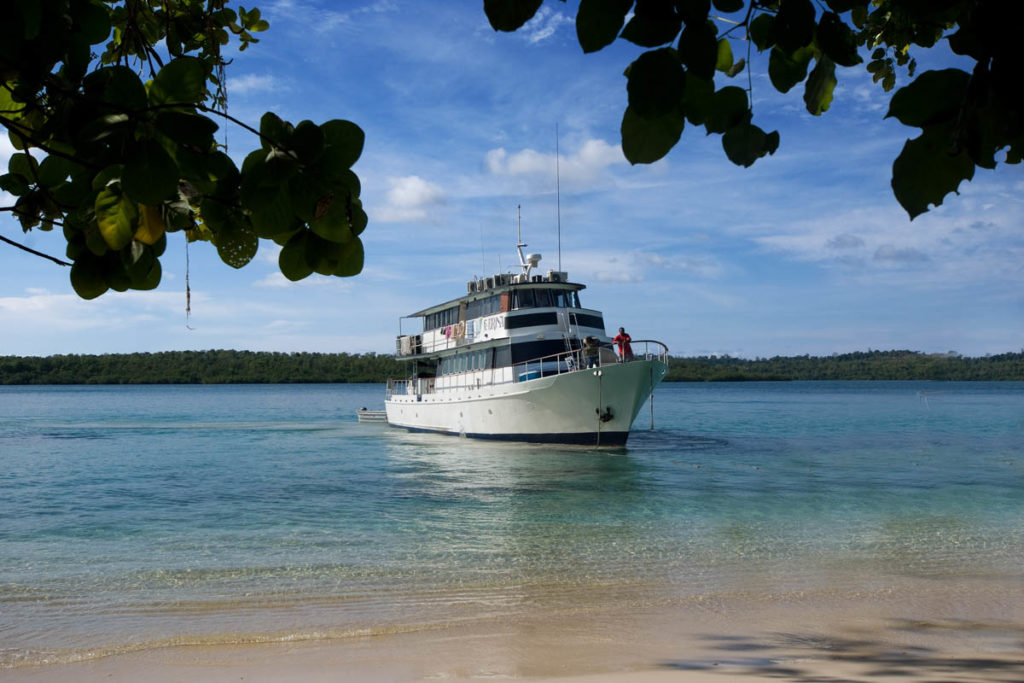Krackafat. If ever a dive site deserved an innuendo-laden name, and there are quite a few in PNG, this is it.
You know you are about to dive somewhere really special when the normally already very enthusiastic crew are like kids on Christmas morning with an Easter egg sugar rush. Digger was buzzing around like he’d had four double espressos, and Josie giggling and bouncing around through her pre-dive briefing. It was 6 AM and they were itching to get under the tree and rip off the wrapping paper. Digger had had a sneak preview when he dropped down to tie on the mooring line. “Looks amazin’ down there!” he said, grinning like the Cheshire cat.
Briefing done, we stride of the water-level dive platform in the balmy 87C water and fin into the gentle current. The FeBrina is hanging off the back of the underwater seamount, moored to the top through a permanent pin some 45 feet down. As I look forward, I can already see why the dive guides were so excited. The far side of the top of the reef is covered by a silvery black cloud. In 2500-odd dives I have never seen anything like it. Horse-eye jacks in their thousands, a giant swarm of them swaying back and forth gently, facing into the current. The top and sides of the mount, the result of the volcano whose crater forms nearby Witu Island, are an explosion of color. Countless crinoids, multiple magnificent anemones, delighful dendronephthya, and clumps of red whip coral adorn the reef. Several species of schooling fusiliers dart to and fro, yellow and white Pyramid butterflyfish fluttered by the hundreds, swarms of anthias loiter around the barrel sponges and black coral trees, as a couple of grey reef sharks patrol in the distance. The is even better than the 90 to 100-foot conditions we’d had the day before in Kimbe Bay, probably 140 feet plus. It’s hard to judge with all the fish getting in the way.
It’s hard to know what to take a picture of. The school of jacks is so big I can barely get a fifth of it in and lit up. The closer I get the larger the school. As I get to the current side of the reef, I descend deeper to try and get under the cloud, and three dogtooth tuna cruise below me. Hanging ay 90 feet, I let the camera hang down and just gawp in wonder. On a fan a longnose hawkfish watches me.
60 minutes later, back on the boat, I ask skipper Alan Raabe what the name means. “Did you get a woody, mate?” he asks in his Australian brogue. I must look non-plussed. “Krackafat, to get a hard on, good old Aussie slang.”
Krackafat is one of a number of reefs around the Witu Islands, about 8 hours’ steam north of Kimbe Bay, off north the coast New Britain Island, in the Bismarck Sea. Very few people live out here, as an afternoon run ashore to visit the village attests, there is no commercial fishing in the area, and the locals fish from dugout canoes. The bottom of the ocean is several thousand feet deep, creating perfect conditions for a superb reef in a country full of them. The colors I’d guesstimate that there are over 300 known dive sites in the country, I’ve dive around 100 of them and not found more than half-a-dozen that weren’t a great dive, most I would rate between “excellent” and “Can I live down here please?”. And Krackafat is probably my favorite of them all.
As Prof Charles Veron, former Chief Scientist, Australian Institute of Marine Science said “These coral reefs take me back forty years, to a time when corals grew in lush profusion, untroubled by the problems that beset them today. I am hard pressed to think of anywhere on earth that has this combination of vibrant health, diversity and beauty.”
The Witus are dived as part of the 10-night Signature itinerary from April to June and September to mid-November, along with Kimbe Bay and Fathers Reefs, altogether forming a triangular tour with an overnight steam between each area.
Kimbe Bay has 40 dive sites on its own, Witus close to a dozen, and Fathers around the same. Kimbe Bay’s outer seamounts are also pelagic fish magnets, and Fathers reefs have yet more barracuda, tuna, batfish, sharks and possibly the world’s friendliest turtles at Jayne’s Gully, a few of whom seem to have formed a particular bond with Digger. Shaggy Ridge and its Silvertip sharks are also at Fathers Reefs, and multiple sites are great for grey and white tip reef shark action.
From January to March the rain fall on the north coast of New Britain, but the mountain range along the spine of the island keeps the south coast dry, and the FeBrina operates out of Rabaul for three months, steaming round to the south coast on nine-night trips. The South coast itinerary takes you diving in the Solomon Sea, just off the 29,988 feet deep New Britain Trench. The nutrients from the uber-deep seem to create a wonderland of rare and unusual critters as well as pelagics.
In March, the 12-night Rabaul to Milne Bay and the subsequent Milne Bay to Rabaul itinerary includes diving in the Milne Bay area, Tufi, the d’Entrecasteaux Islands of Normanby and Goodenough and along the southern coastline of New Britain at Lindenhaven.
Whilst the boat is certainly not the most luxurious vessel by 21st century standards, the individually air-conditioned cabins do the job, and the FeBrina is a great dive platform with ample room for camera equipment and battery charging. I’ve done four trip son her now, and am itching to go back as she goes to what I consider to be the most beautiful, unspoiled dive sites on the planet.
5 Reasons to Dive MV FeBrina
- Photography ops. The variety of subjects is almost unlimited. From schooling jacks and barracuda in superb viz every day, turtles and sharks, to the plethora of macro subjects including rarities like Coleman’s pygmy sea horse, Lacy scorpionfish, at least four species of ghost pipefish, more tiny crustaceans than you can shake a stick at, with undescribed species to be found (I found two on one trip in 2013). You could shoot macro on every dive, and wide angle on all but a few dedicated muck dive sites.
- The guides: Josie and Digger have been guiding here for a couple of decades and they know where to find whatever it is you want to see. Digger also has an excellent eye for composition and is always willing to show you the optimal spot for a killer shot.
- The people. New Guineans are the friendliest people on the planet and their good humor is infectious. Local kids paddle out to the boat to sell fruit and veg and fish (and to look at the funny people with all the crazy gear on) and are happy for their picture to be taken.
- The locations. Whether you are diving the outer reefs of Kimbe Bay, Fathers Reefs, the Witus, you will be in the middle of nowhere, stunning volcanic silhouettes on the horizon, or even moored in an extinct crater at the Witus. On the South Coast you are close to local villages, making for some more topside photo ops.
- The dive site variety. It’s the best reef diving I have done anywhere. It doesn’t have the manta action of Raja Ampat, but the size of the fish schools are unparalleled and the reef shark action is good. There are pinnacles, sea mounts, black sand dives, swim throughs, arches, overhangs, and passes. And there are four different itineraries to choose from.
When to Go
The 7 and 8-night itineraries run mid-June to early September, mid-November to end of December, The 10-night signature itinerary runs April to mid-June and September to mid-November. The New Britain South Coast itinerary is on in January and February, and the trans-Solomon Sea 12-night trips run in March.
Travelers Tips
From the US: Fly from LA direct to Brisbane direct in 14.5 hours, change planes for a three-hour flight to Port Moresby, the capital of PNG. From Europe, Qatar has good routes through Doha and Singapore and Manila. Travel time is around 26 hours from a major European city to Port Moresby. Once you clear Customs and Immigration and then change again for the 90-minute flight to Hoskins. The road transfer from the airport to the boat takes approximately one hour. Divers get an extra 15kg hold baggage allowance on top of the standard 15 kg for domestic flights.
Good chocolate is hard to come by, as are the latest DVD releases. Take a few large bars and some downloaded movies on a memory stick for the crew.
Using a PNG specialist agency like Best of PNG (www.bestofpng.com), it is easy to combine a Febrina cruise with cultural land tours or some resort diving at one of the five dives resorts elsewhere in the country.
Dive Conditions
With temperatures are between 28 and 31 C, only a light wetsuit or rash suit is required. Visibility between 30 and 40 metres. With mild currents on pinnacles on rising and falling tides, a weighted line runs under the boat to the mooring pin on all sites. Almost all dives are from the rear duckboard and back onto the rear duckboard. Most days there are four day dives and a night dive, unless there is a long stretch of navigation.
The Boat
www.febrina.com: With a 73-foot long steel hull and steel/aluminium superstructure, MV Febrina’s classic design and 7 below deck en suite cabins with individual air-conditioning house 12 divers. Two of the cabins, those closest to the engine room and generators, are single occupancy only. With a crew of 8, there is always someone to help out. She sails out of Walindi Plantation Resort, near Kimbe, West New Britain Province. She’s not a luxury boat – only the lower deck and main deck are accessible to guests, there is no sun deck or hot tub – but the crew provide five-star service and the food that comes out of the galley is excellent, lunches especially.
Learn more at: https://www.indigosafaris.com/










